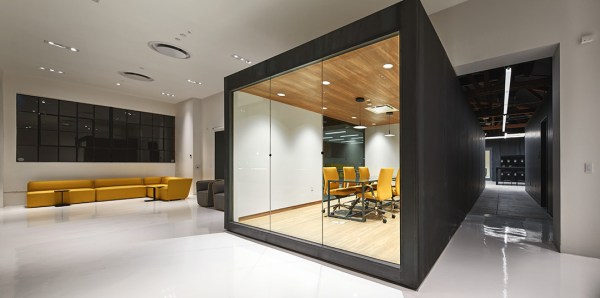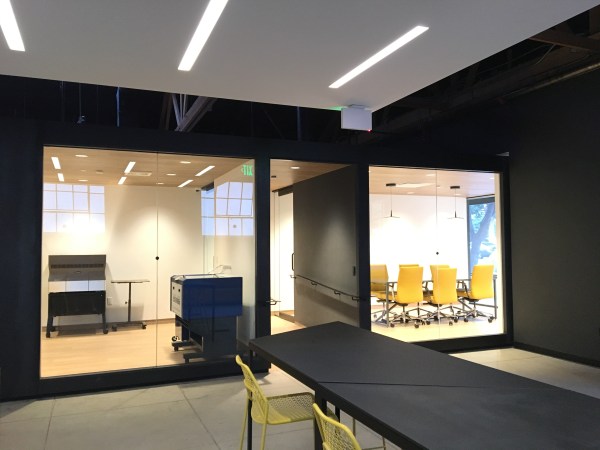The big news story of the week of course has been the wildfires in California, which as of Saturday have burned over 30,000 acres, destroyed 12,000 structures, caused 150,000 people to evacuate, and killed eleven people. Actually, calling them wildfires underplays the situation a bit because there are places where they’ve clearly become firestorms, burning intensely enough to create their own winds, consuming everything in their path in a horrific positive feedback loop. We’ve even seen fire tornados caught on video. We’ve got quite a few connections to the affected area, both personally and professionally, not least of which are all our Supplyframe colleagues in Pasadena, who are under immediate threat from the Eaton fire. We don’t know many details yet, but we’ve heard that some have lost homes. We’ve also got friends at the Jet Propulsion Labs, which closed a few days ago to all but emergency personnel. The fire doesn’t seem to have made it down the mountain yet, but it’s very close as of Saturday noon.
pasadena7 Articles
A Wallflower Jumps Into The Los Angeles Unconference
When I was asked to cover the Unconference in Los Angeles last week, I have to admit that I was a more than a little uncomfortable with the idea. I’m not big on traveling, and the idea of meeting a lot of folks was a little intimidating. Surely meeting Hackaday readers in person would be like walking into a real-life version of the comments section of a particularly controversial post. Right?
I couldn’t have been more wrong.
The LA Unconference, held at the Supplyframe Design Lab in Pasadena, was a far more collegial and engaging conference than any I’ve been to in my professional life. I couldn’t have asked for a better group to share the afternoon and evening with, and the quality of the talks was excellent. The Design Lab turned out to be a great space for the event — a large main room for the talks with plenty of little areas to break away for impromptu discussions and networking.
Continue reading “A Wallflower Jumps Into The Los Angeles Unconference”
Supplyframe Design Lab Opens Its Doors
Today marks the opening of the Supplyframe Design Lab in Pasadena, California. The Design Lab bills itself as the “leading edge creative center built to foster new ideas in technology and design”. Supplyframe had the vision to acquire Hackaday a few years ago, launched the Hackaday.io Community site which now has more than 150,000 members, and established The Hackaday Prize to spark engineering projects that benefit humanity. Pay attention to the Design Lab; looking back on this day you’re going to be able to say that you remember when it all started.
The equipment enshrined in the new space is spectacular. Name your material, and there are tools to work with it. Working with electronics? Mill your prototypes on a number of OtherMills available. Custom enclosure? Take your pick of milling it on the Tormach, PolyJet printing it on the Statasys, or FDM printing with a number of different high-end 3D printers. Need design software and beefy boxes to run it on? They have that too. Working in wood? A shopbot awaits you, as do traditional tools like a tablesaw, routers, sanders, etc. It’s a wonderland for making the imaginable real. If there ever was a time to quit your job and spend three months launching that dream product, this is it. The Design Lab has a residency program.
Supplyframe is all about enabling hardware creation. This is what sites like Parts.io and Findchips.com do: provide powerful tools for hardware engineers to better use their design skills. Founding a space like the Design Lab is a natural extension of this. Providing a work area, mentorships, and funding residencies breaks down the barriers that can prevent new hardware seeing the light of day. The Design Lab solves the issues of tools, materials, and hands-on experience that plague many a new hardware company.
Residencies will start on July 1st. Each runs for three months in which residents have unfettered access to the space and its tools, as well as financial support of $2000 per month. Each resident will self-identify into the product-track (you’re on your way to market with new hardware) or the art-track (you have a calling for an ambitious project and need to make it a reality). So far the Design Lab page lists three residents; a network of low-cost air quality sensors called Scintilla, a music synthesizer based around Teensy 3 called NanoEgg, and a mixed-reality public arts initiative called Perceptoscope. The Design Lab is still accepting applications for new residencies this summer and beyond — one of these residencies will also be offered to the Grand Prize winner of the 2016 Hackaday Prize.
Supplyframe Design Lab Residency Applications Now Open
The Supplyframe Design Lab in Pasadena, CA is opening soon. This space is dedicated to making great ideas reality. It is packed with state of the art tools, with plenty of room for classes and collaboration.
Professional level tools and an available workshop are just one piece of the puzzle. To be truly successful, great people need to bring the space to life with inspiring builds and forward thinking adventures. If you want to be part of this community, and have been contemplating an idea for your next product or project, consider applying for a funded residency.
Art, Product, and Technology projects will all be considered. Those selected will be funded up to $2,000 per month. We want to see ambitious projects realized at the Design Lab so don’t be afraid to think big. To help in curating the best projects to fund we’d like to see some of your previous work. If you haven’t already, please share some of your builds on Hackaday.io. The first round of funded projects can be under way as early as June 1st.
Hackaday Prize Worldwide LA: The Ultimate Workshop, Party, And Hackathon
The Zero to Product workshop, held at the Hackaday Design Lab in Pasadena two weeks ago, was a packed house of talented people seeking to expand their skill set with professional PCB layout tips and tricks. [Matt Berggren] didn’t disappoint, bringing his professional experience to the table in a way that anyone with basic electronic knowledge can grasp. Learning the things that make a board reliable and manufacturable can be done with a simple design. In the case, the culmination of the workshop is development board to host the ESP8266 WiFi modules that have been so popular over the last half-year.
This isn’t the first time we’ve pulled off a massive hardware hackathon and meetup, and it certainly won’t be the last. You have another chance to participate in the workshop in San Francisco on June 13th. If you can’t catch that one, we’ll be in Shenzhen for the Shenzhen Maker Fare, a Zero to Product workshop, and a meetup.
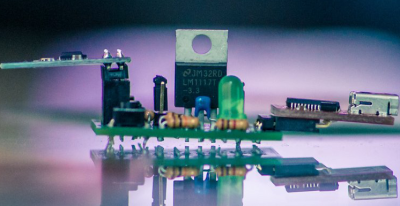
Of course Hackaday events are never “all work and no play”. The day crept into night and the the chairs were cleared out for hightop tables and tasty beverages. The atmosphere was festive and everyone still made it back early the next morning for an entire day of hardware hacking, tinkering, and general futzing around with circuits and electrons. If you check out [Rich Hogben]’s photo log of the weekend, you’ll find some an impressive collection of hackers were there. I see at least one person who’s job is flying space probes, a Hackaday Prize judge, and a security researcher who can crack a Master Lock in 30 seconds.
![The display for [Steve]'s LIDAR](https://hackaday.com/wp-content/uploads/2015/05/lidar1.jpg?w=400)
Bar-time Show and Tell
The meetup Saturday night wasn’t technically a bring-a-hack event, but we walwasy want to see people’s latest and greatest contraptions. [Steve Collins] brought a homebrew LIDAR. This project was based on a SparkFun Time of Flight breakout board that scans the room with a cheap hobby servo, reads the data into an Arduino and displays the rangefinding data on a small TFT. The LIDAR is good enough to scan the entire Hackaday Design Lab, with more than enough resolution for any robotics project you have in mind.
Also at the Saturday night gathering was our very own mythical creature [Sophi Kravitz], [Elecia White] who is and embedded.fm podcaster, engineer, and Hackaday Prize judge two years in a row, and [Samy Kamkar] known for his privacy and security research and for building the KeySweeper. They gave a series of lightning talks about the latest things they’re working on:
We rented Galaga and Ms. Pac Man machines for the entire weekend, but that wasn’t the only electronic entertainment for the party. Two Bit Circus was there with a game that could only be described as highly disorganized electronic chess. FLED, the exceedingly large, high-resolution RGB LED display was behind the bar, and Deezmaker took over a room to 3D scan people and print out miniature clones on a pair of 3D printers.
The Hackathon
The events continued on until Sunday evening with a hardware hackathon. This isn’t your run-of-the-mill software hackathon where people sit behind their MacBooks the entire time; we had soldering irons, components, solder, solder wick (important!) and dozens of hardware hackers tinkering away at their latest electronic doodad.
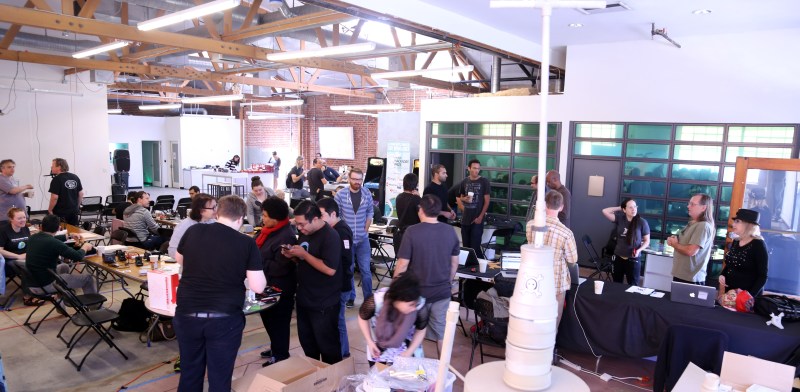

The amount of hardware on hand was spectacular. Hackaday Prize sponsors Atmel, Freescale, Microchip, and TI all provided some hardware. Everything from ATMega328 boards from Atmel, TI Launchpads bristling with goodies like the Sharp Memory Display booster packs, Seeed Studio starter packs, to insanely powerful Freescale Freedom boards were available to build on at the event. The Sunday hackathon also had several gigantic boxes from Mouser filled to the brim with components and breadboards available to everyone to clobber into submission, letting their inner electronics geek shine.

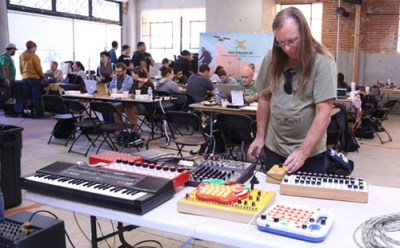 When taking a break from the build there was plenty to look at. People were showing off already completed projects they brought along with them. [Jeff] from Circuitry & Poetry was there with a bunch of circuit bent synths. A number of people were also finishing up the ESP8266 breakout boards that were presented the day before; some soldering and some laying out a PCB in Eagle. It was an incredible event, with dozens of groups going off to do their own thing, but still welcoming to anyone else who wanted to tinker. This type of community isn’t found everywhere and we’re thankful for the people that make Hackaday events like this one so special.
When taking a break from the build there was plenty to look at. People were showing off already completed projects they brought along with them. [Jeff] from Circuitry & Poetry was there with a bunch of circuit bent synths. A number of people were also finishing up the ESP8266 breakout boards that were presented the day before; some soldering and some laying out a PCB in Eagle. It was an incredible event, with dozens of groups going off to do their own thing, but still welcoming to anyone else who wanted to tinker. This type of community isn’t found everywhere and we’re thankful for the people that make Hackaday events like this one so special.
We need to take the time to give a big shoutout to SGVHAK. We honestly couldn’t have done this event without them. I’d personally like to thank [Michael Proctor-Smith] for bringing his amazing livestreaming box. He is the reason I am not currently (still) editing down seven hours of video from the PCB design workshop and the lightning talks. Big ups to [Lan], [Scoops] and everyone else who helped out. If you came to the Hackaday event, check out their meetups. If you’re in the area, we also have regular informal meetups somewhere around the hackerspace. Come on out!
How To Make Hardware, With Examples And An Electric Pickle
Right now we’re throwing a two-day hackathon in Pasadena. As with all hackathons, people are going to build something, but that’s only going to happen today. Yesterday was an incredible Zero to Product talk that goes over PCB layout techniques, manufacturing, and schematic capture. In a seven hour talk, our own [Matt Berggren] took the audience through building a product, in this case a little ESP8266 breakout board. We livestreamed this; the video (and electric pickles) are below.
Continue reading “How To Make Hardware, With Examples And An Electric Pickle”
Live Now: 2015 Hackaday Prize Worldwide: LA
Right now we’re throwing a huge workshop, meetup, and hackathon in Pasadena.
Events include a ‘Zero to Product’ workshop that will take everyone through PCB design, manufacturing techniques, CAM, soldering, testing, and blowing up caps and releasing blue smoke. You can check out the live stream of that here (or below).
Later on this evening, we’ll be having a few short talks from some LA-area hackers, builders and engineers.
Tomorrow is Open Hack Day, where the Hackaday Design Lab will have tables filled with components, dev boards, soldering irons, and enough blinkey stuff to blind someone. Live stream below.
Continue reading “Live Now: 2015 Hackaday Prize Worldwide: LA”



